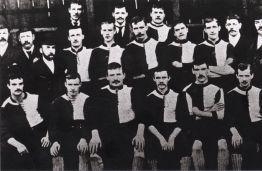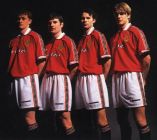| Manchester United Club Profile - The Strip
|  |
When Newton Heath first took to the field at their North Road ground in 1892, the players wore red-and-white quartered jerseys and blue shorts - a strange combination, even in those early days, but stranger kits were to come. From 1894 to 1896, the team wore distinctive green and gold jerseys with laced collars. In 1896, the green and gold jerseys were replaced by a kit that featured a white shirt with blue shorts but this new strip brought no better fortunes to the club, who struggled in the recently formed Second Division of the Football League. It wasn't until Newton Heath became Manchester United in
1902 that they started to wear the famous red shirts with white shorts.
During the 20th century, the football strip evolved from an unconventional jersey to a fashion accessory worn by millions of fans. Rival sports manufacturers now bid for the rights to mass-produce kits in a multi-million pound worldwide industry. Sporting a replica of the kit worn by your heroes is a trend that really took off in the 1970s and 1980s, and became hugely popular in the 1990s. At this time many clubs, including Manchester United, began to change their strips more and more frequently.

When John  Davies, a wealthy local brewer, took over as chairman of the club in 1902, the name Newton Heath disappeared for ever in favour of Manchester United. Davies was the man eventually responsible for United's move to Old Trafford, but one of his first moves was to change the colours of the first team strip to the famous red and white that we know and love today.
Initially football jerseys were made of wool, but wet weather, not uncommon in Manchester, would weigh the players down and it wasn't long before wool
was superseded by the lighter cotton, flannel or cotton twill. Over the next few decades there were few changes to the United shirt, although from 1922 to 1927 players wore a white shirt bearing a deep red "V' around the neck. The red and white colour combination has remained the most popular. In 1934 United wore maroon shirts with white hoops, and they finished 20th in Division
Two, the club's lowest ever League position. The red shirt was duly recalled.

Although United have been known as the "Red Devils" for many decades, the red shirt has been notable by its absence for some of the club's greatest achievements. In 1948, when United beat Blackpool 4-2 to win their first FA Cup since 1909, a deep blue shirt was worn to prevent a colour clash with the Blackpool shirts. In United's finest hour the European Cup win over Benfica at Wembley in 1968, the team wore royal blue shirts, produced especially for the game. In 1991, when United beat Barcelona in Rotterdam to lift the European Cup Winners' Cup, they played in special white shirts.

Styles changed very little after World War Two.  The '5Os again saw a plunging "V' neckline. Home shirts were red with a white "V'. and away shirts were white with a red "V". In the '60s this "V' was ditched in favour of a round collar, with the red and white trim still being reversed for home and away games. The '5Os again saw a plunging "V' neckline. Home shirts were red with a white "V'. and away shirts were white with a red "V". In the '60s this "V' was ditched in favour of a round collar, with the red and white trim still being reversed for home and away games.
The United strip didn't have a badge on the chest until the early 1970s, unless the team were playing in a Cup Final. Then, in the 1957 and 1963 FA Cup Finals for example, the badge of the Manchester County Football Association, featuring the Manchester coat of arms, was sewn on to the chest. The only exception to this tradition was in the 1958 FA Cup Final, just three months after the tragedy at Munich. For this poignant game, a symbolic badge was produced that featured a phoenix rising from the ashes. Sadly, if unsurprisingly, United lost, and it was to be 10 years before the club rose to greatness again.
In the main, football shirts stayed plain, functional and cotton until the late '70s, when synthetic materials became available, but football shorts had been getting shorter since the '60s, and long, baggy shorts were seen as a relic of days gone by. By the mid '80s shorts were so short that -ome players looked as though they were in severe discomfort. Italian clubs reintroduced longer shorts and English clubs soon did likewise, wearing the looser, more casual shorts that are still popular today. The multi-coloured goalkeeper's jerseys are designed to dazzle opposing strikers, and have become more garish over the years.


The United badge was added to shirts in 1973, and the whole kit underwent a major change in 1983, when the club signed its first shirt sponsorship with Sharp Electronics. Sharp, a Japanese company, have their UK base in Newton Heath, and United's association with Sharp was to continue for many years. Initially, however, television companies refused to cover matches played in sponsored shirts and for a time United wore the Sharp logo only for matches that would not be televised.
German sportswear giants Adidas produced United kits for over 10 years, right through the 80s to the early 90s. During this time, United had a red home shirt, a
white away shirt and an all-blue third strip worn for away games at Southampton, Sunderland and Arsenal, whose home strips clashed with United's first two strips.
Manchester United changed their kit manufacturers from Adidas to Umbro in 1992. Umbro had strong links with Manchester; the company was formed in nearby Wilmslow
in 1924. The Manchester United shirt is their biggest seller worldwide. In fact, United's home shirt is the best-selling football shirt in the world and provides the club with important revenues for improving the stadium's facilities and the squad.


Today's shirts are worn as fashion items by fans keen to show their allegiance to Manchester United. The home and away kits are updated in twoyear cycles, although there have been special kits for Europe, and kits such as the grey away kit in 1995/96, which lasted just nine months. First worn competitively in a 3-1 defeat to Aston Villa, United didn't record a single victory in the kit. The final straw came at Southampton in early 1996. After going three goals behind to a team fighting relegation, United players complained that they couldn't see each other and changed strips at half time. They could not pull back the deficit, losing 3-1, and the dreaded grey kit was never worn again.
The red United home shirt is probably the most recognisable football shirt in the world. The full strip, with white shorts and black socks, is highly distinctive, and is a part of the tradition that has made Manchester United the worldwide institution that it is today.

© Patrick Eustace 2000. Page maintained by Patrick Eustace, last updated Sunday, 16-Jan-2000 19:59:46
| |
|



